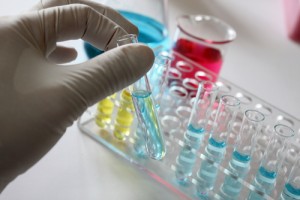8 Compounds Potentially Useful For Treating MS Discovered Using Innovative Research Tool
Written by |

 Eight new drugs that are able to stimulate the nervous system were discovered by a research team at UC San Francisco recently. The team utilized a novel screening platform and examined the cellular effects of 1,000 chemical compounds. The scientists believe the discovery may impact the treatment of the tissue lesions caused by multiple sclerosis (MS).
Eight new drugs that are able to stimulate the nervous system were discovered by a research team at UC San Francisco recently. The team utilized a novel screening platform and examined the cellular effects of 1,000 chemical compounds. The scientists believe the discovery may impact the treatment of the tissue lesions caused by multiple sclerosis (MS).
After analyzing 1,000 compounds, the scientists excluded most of them as potentially therapeutic, but were able to identify eight that share a common mechanism of action that they believe can be beneficial in the treatment of MS. The antihistamine clemastine was the most effective of all 1,000 compounds tested, as it blocks the actions of histamine in mucous membranes.
“A major unmet need in the development of therapeutics for repair in MS has been the ability to screen compounds in a high-throughput manner,” said Jonah Chan, PhD, the Debbie and Andy Rachleff Distinguished Professor of Neurology at UCSF and senior author of the new study.“Through a great deal of serendipity, combined with the hard work of outstanding students and colleagues, we have been able to address this need, and I am happy that we are already testing one compound in the clinic.”
[adrotate group=”4″]
The decision to focus on compounds already approved by the FDA was driven by study co-author, Dr. Stephen Hauser, the Robert A. Fishman Professor and chair of the Department of Neurology at UCSF. The study was originally published in the journal Nature Medicine. As founder and director of UCSF’s interdisciplinary MS Research Group, Hauser has championed efforts to translate insights from basic neuroscience research into new therapies as quickly as possible. The new study is a perfect example of that strategy: only 14 months have elapsed since the team performed the first drug screen, and the Phase 2 trial is already at its halfway point.
 The immune system of patients with MS attacks the fatty sheath that covers the the thin nerve-cell extensions called axons, affecting the flow of information between the brain and the body. Myelin is essential to providing insulation to quick, efficient communication among neurons. When it is damaged, patients suffer lesions oh the axons, death of the nerve cells and progressively worsening of the symptoms. Myelin is wrapped by specialized cells called oligodendrocytes, within the myelination process, which is largely studied by the authors.
The immune system of patients with MS attacks the fatty sheath that covers the the thin nerve-cell extensions called axons, affecting the flow of information between the brain and the body. Myelin is essential to providing insulation to quick, efficient communication among neurons. When it is damaged, patients suffer lesions oh the axons, death of the nerve cells and progressively worsening of the symptoms. Myelin is wrapped by specialized cells called oligodendrocytes, within the myelination process, which is largely studied by the authors.
In order to study the layers of wrapping individually, researchers designed a new system based on fabricated conical micropillars, with only a few thousandths of an inch thick at its base. They have created plates of 96 micropillar wells and loaded up each one with 40,000 oligodendrocyte precursor cells (OPCs), the cells from which oligodendrocytes are derived in the brain and spinal cord.
From there, the researchers started analyzing 1,000 compounds from the FDA library, applying them in the wells with an automated screening platform. With a confocal microscope to view the slides from below, the scientists were able to determine from the color of the cells if they had differentiated into oligodendrocytes, as well as calculate how thoroughly it wrapped the micropillars.
 Although the majority of the compounds analyzed killed the OPCs or did not cause any benefit to their development, eight of them successfully prompted OPCs to differentiate into oligodendrocytes and robustly wrapped the micropillars with layers of myelin.
Although the majority of the compounds analyzed killed the OPCs or did not cause any benefit to their development, eight of them successfully prompted OPCs to differentiate into oligodendrocytes and robustly wrapped the micropillars with layers of myelin.
“It is imperative that we exploit and utilize the power of our screening platform to search for additional compounds, but another next step is to identify the receptor targets of these anti-muscarinic drugs so we can develop therapeutic compounds with minimal side effects,” said Chan.
“There are five different muscarinic receptors expressed in the nervous system, and a major question is whether the effects we observed are the result of blocking a single receptor or a combination of multiple receptors. Understanding the molecular mechanisms responsible for oligodendrocyte differentiation and myelination will provide valuable insight into the repair process and guide the development of new effective therapeutics for remyelination,” he explained.
Researchers were especially enthusiastic about antihistamine, despite the fact that it also has an “off-target” effect of blocking muscarinic receptors in the brain and elsewhere in the body. All of the compounds have the same capacity to block a particular receptor, the muscarinic receptor, on a subset of OPCs that respond to the neurotransmitter acetylcholine.
All of the compounds are approved by the U.S. Food and Drug Administration (FDA) and used to treat other diseases, however, scientists recommend MS patients not to try any of the compounds until further clinical trials establish their safety and effectiveness in the treatment of the disease. The proper dosage hasn’t been stated as well. The next step for the UCSF team is to start phase 2 clinical trials, which will be led by Dr. Ari Green and is expected to be completed by the end of 2014.





